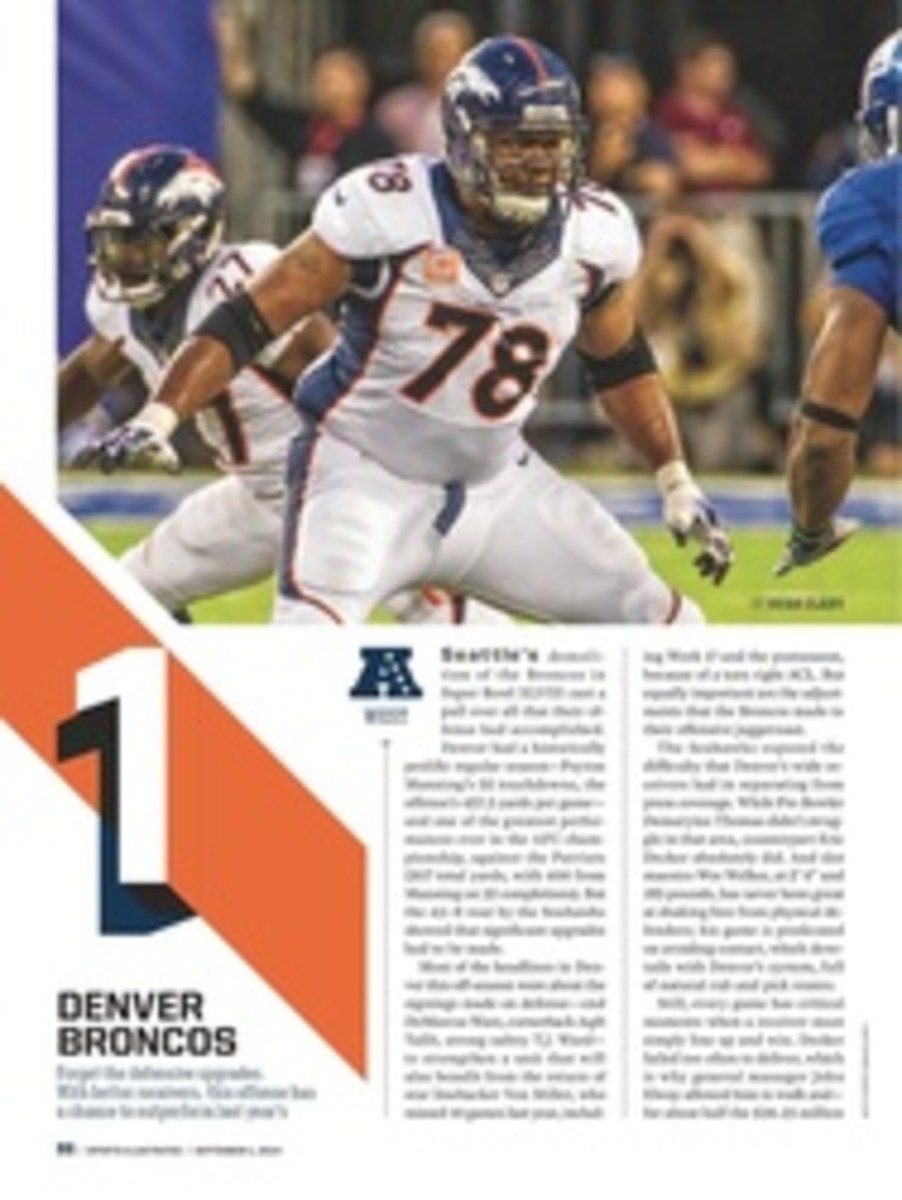
2 NEW ORLEANS SAINTS
The best way to learn more about the inner workings of football is to pay close attention to how teams line up. Formations rarely get discussed by broadcasters, but they're the DNA that dictates play design and creates key matchups, and they implicitly reveal how a team feels about its own players as well as its opponents'.
For an advanced lesson on formations, there's no better case study than the Saints. Part of coach Sean Payton's M.O. is to employ 15 different formations over his offense's first 15 plays—give or take—so that his assistants can chart how the defense responds to each one. Payton then bases much of his play-calling on that info.
This practice is not uncommon in the NFL, but New Orleans—given Payton's craftiness and quarterback Drew Brees's sagacity—is the best at it. And the assortment of formations does not stop at 15. The Saints simply have too many offensive looks for a defense to prepare for, and New Orleans is able to run those out of myriad personnel groupings thanks to its depth at running back, receiver and tight end. The Saints are bound to find favorable mismatches.
Even when the defense can decipher what's coming, there's this to deal with: Brees is as adept as anyone at clicking through progressions, and Payton is among the elite at constructing route combinations, particularly with screens, seam patterns, posts and deep crosses.
Most of these designs take time to unfold, which is why GM Mickey Loomis has invested heavily in his offensive line—or at least in the interior. (With a 6-foot quarterback who struggles to see over blockers and attackers, it's imperative that the pocket stays firm in the middle.) Guards Ben Grubbs and Jahri Evans earn more than three times what tackles Terron Armstead and Zach Strief earn. Payton's system makes great use of chip blocks (that is, quick double-team blocks from a back or a tight end as he releases into a route), so having elite tackles is not vital. These chips, by the way, are one reason the Saints use so many condensed formations.
Instrumental in many of those chip concepts is tight end Jimmy Graham, who is by far the Saints' most dynamic weapon. With his receiver's speed (4.56 40-yard dash) and tight end's size (6'7", 265 pounds), Graham gives a formation versatility, and where he lines up often dictates how the defense lines up. Most corners are too small to cover him, most safeties are too slow, and there are fewer than five linebackers in the league who can contain him without help.
With such a refined system New Orleans doesn't need stars around Graham—but having more wouldn't hurt. The Saints hope, then, that rookie wideout Brandin Cooks can quickly become a threat. The darting, shifty first-rounder (Oregon State) will fill many of the underneath receiving duties once handled by Darren Sproles, who caught 232 passes over the past three seasons (an NFL high for a running back) before being traded to the Eagles in a cost-cutting move. New Orleans also needs Cooks to create his own opportunities against tight coverage on the outside—something that no one else, including decorated possession target Marques Colston, is capable of doing.
Cooks won't make many catches out of the backfield, like Sproles did, but the Saints won't need him to. Running back Pierre Thomas is an adept receiver, especially on screens, where he has an excellent sense of spacing and timing. Thomas is also a steady ballcarrier, though his touches will be limited in a backfield trio that includes Mark Ingram and Khiry Robinson. Ingram, the 2009 Heisman Trophy winner, has not fully panned out, but with perpetually fresh legs he can be a difficult downhill bouncer to corral. Robinson, a second-year pro with excellent burst and control, is viewed by many (including Payton's longtime mentor and friend Bill Parcells) as a budding star.
Distribution in Payton's deep, lavish offense will remain as diverse as the coach's formation usage. Last year, seven Saints had at least 450 yards from scrimmage—pretty much par for the course since Payton and Brees arrived in 2006.
And there will be opportunities for more in 2014. With New Orleans's defense coming to life under coordinator Rob Ryan, Brees won't always be compelled to score in a hurry. That should result in more balanced play-calling. The defense's awakening, by the way, has come about from having a rich variety of concepts and personnel groupings—and from a seemingly endless supply of formations.
2014 SCHEDULE
2013 Record: 11--5
WEEK 1
ATL [AWAY]
CLE [AWAY]
MIN [HOME]
DAL [AWAY]
TB [HOME]
BYE MON
DET [AWAY]
GB [HOME]
CAR THUR [AWAY]
SF [HOME]
CIN [HOME]
BAL MON [HOME]
PIT [AWAY]
CAR [HOME]
CHI MON [AWAY]
ATL [AWAY]
TB [AWAY]
WEEK 17
KEY CONCEPT
Swarming
The swarming nature of the Saints' defense makes it appear as if they have a fierce pass rush. Look closely, though, and you'll see a front seven without any true edge specialists. The nearest thing they have is Junior Galette, a fifth-year outside linebacker with adequate speed but occasional bouts of ineffectiveness. Coordinator Rob Ryan compensates with keen blitz designs as well as blitz looks that wind up bringing only the standard four rushers. Despite the lack of raw edge speed, Ryan's full playbook is available mainly because he has fundamentally sound players up front, starting with tireless end Cameron Jordan and, opposite him, budding star Akiem Hicks, who was a top five run defender last season. At the very least, Jordan and Hicks can prevent run blockers from cleanly working their way up to the second level, allowing speedy inside linebackers Curtis Lofton and David Hawthorne to play in full-on attack mode, swarming freely.
THE CASE FOR
Strong safety Kenny Vaccaro
The 2013 first-round pick does much more than his listed position suggests. Vaccaro is a deft slot defender, thanks to man-coverage skills honed at Texas and his natural violence as a press-jammer and tackler. He's also a heady linebacker, capable of slithering around bodies much as Charles Woodson did in his days as a Packer. And, of course, the 6' 215-pounder can also play the traditional strong and free safety roles just fine—but on his most creative days, coordinator Rob Ryan won't ask Vaccaro to do that. In the dime packages that Ryan loves, all three safeties get a chance to move around, which explains the acquisition of free-agent playmaker Jairus Byrd, a three-time Pro Bowler at safety in Buffalo. Interchangeable safeties are most dangerous playing alongside quality man-to-man corners. The Saints have one of those in Keenan Lewis, who is ascending toward the top echelon at his position. And they hope to get one or two more quality years out of Champ Bailey before the free-agent pickup's five-year countdown to Canton begins. The No. 3 corner spot is up in the air; Corey White figures to have the inside track. But thanks to the flexibility provided by Vaccaro, New Orleans can still be effective if no one emerges.
PHOTO
DERICK E. HINGLE/USA TODAY SPORTS
TE JIMMY GRAHAM
PHOTO
DERICK E. HINGLE/USA TODAY SPORTS
NINTEEN PHOTOS

